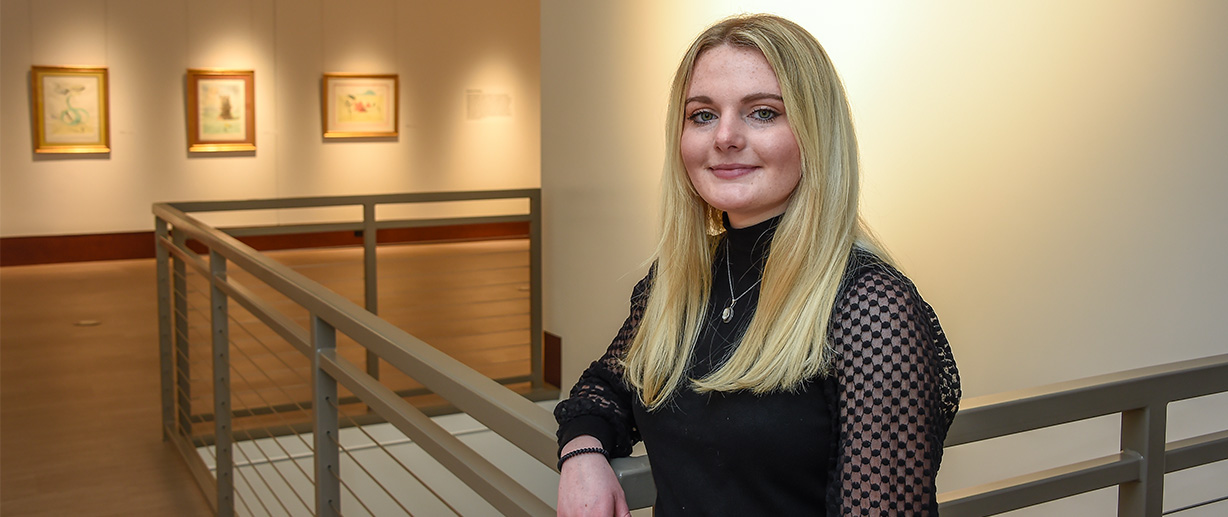By Eyon Brown, communications intern
A senior art history and history double major from Knoxville, Tennessee, Mancini took Schmunk’s Architecture 201 course during her freshman year for a general education requirement, a course that she was not optimistic about going into it.
“I never considered myself artistic and dreaded anything creative,” she says. “I ended up loving the class, taking his History of Western Art II the following semester and then taking every class I could of his until he retired.”
Mancini’s capstone project, titled “The Art of Printmaking: Global and Historical Approaches,” debuted at the Rosalind Sallenger Richardson Center for the Arts on Feb. 9. It features various works curated by Mancini that present different styles of printmaking and historical methods of production.
Printmaking, which has origins dating back as far as 2500 B.C., is the creation of an image for the purpose of producing multiple copies. It involves a carving or etching of an image into a woodblock, onto a plate or a lithographic stone, followed by a transmission process either by hand, by press or by photomechanical technology to transfer the image to paper.
“In the exhibit in the gallery,” Mancini says, “we have prints from the Renaissance (when printmaking became institutionalized in Europe), 19th century Japan, and 20th century propaganda, contemporary art, etc. Many people think that printmaking began with the press, and while it was an important innovation, prints were made by hand thousands of years prior and continue to be made this way.”
The project originally was not Mancini’s own. It began with Wofford curator Dr. Youmi Efurd expressing to Mancini that she was interested in an exhibit on printmaking and asking for help. Mancini’s role was primarily rooted in research and a bit of curation, but not the entire exhibit. After a while, though, things changed.
“I ended up receiving funding from Wofford and (South Carolina Independent Colleges and Universities) for the research and was able to remain on campus this summer to research, and also was allowed to conduct it as my senior capstone project in the fall,” Mancini says. “Somewhere in the mix of all that I took on a much larger project, choosing the works with guidance from both Dr. Efurd and my academic and capstone advisor, Dr. Karen Goodchild.”
Mancini also says that she was wholly supported by Efurd and trusted with the responsibility of deciding which works to exhibit. She followed three specific criteria: variety of historical periods and areas, significance to her research and to general art history, and her personal favorites.
“Sometimes it came down to choosing one or two prints from a group and that was based on my personal interest, taste, and understanding of it,” she says.
She often worked with Dr. Goodchild on research and writing, as well as outreach to museums and other colleges and universities to obtain certain works. Most of all, Mancini was able to lean on other professors within the department for their expertise in different periods and cultures.
“I sought help from Dr. Goodchild when needing her art historical insight on Western, Renaissance and European prints,” Mancini said, “while I sought advice from Dr. David Efurd (our Asian art historian) for help with Japanese prints.”
After the work came the most important part of the exhibit – obtaining the works themselves. She was able to borrow Rembrandt and Dali prints, among others, from Bob Jones University. The Georgia Museum of Art also loaned two prints from Albrecht Durer and one from Henrick Gotlzius.
“Without the lending of these prints, the breadth of my exhibit and research would have been much more limited,” she says. “They helped me expand broader and provided key works to my studies.”
Mancini’s exhibit will run through the spring semester and is available for viewing by the campus community from 1 to 5 p.m. Tuesday through Friday. The exhibit is open to the public from 5 to 7 p.m. on Thursday evenings. Admission is free, but reservations must be made 24 hours in advance and masks must be worn. To make a reservation, call 864-597-4940 or email artmuseum@wofford.edu.
